Angkor without tourists#
by
All pictures were taken by the author and are protected by copyright.
In the middle of August 1990, we (three people) met in Bangkok to travel to Angkor from there despite the known problems in Cambodia at the time. Adele Drexler and I just came from Indonesia, where we had already traveled intensively to the islands of Bali, Java and Sumatra. Ingrid Schmiederer went directly from Austria to Bangkok by plane. After the visit of Angkor we wanted to make a trip through Thailand.
After a tasty Asian meal we went to the office of the Cambodian airline together, with which we wanted to take a plane back from Bangkok via Ho Chi Minh City (Saigon) to Phnom Penh and also back the same way. At that time the only possibility to enter Vietnam was via Cambodia and it was relatively difficult to get a visa for Cambodia at all.
Already in Austria we had found flights, but could not book them, so we tried to reserve them; now it turned out that even the reservations had not worked. We were only able to book the flight to the nearest destination airport in each case, in this case to Ho Chi Minh City, the former Saigon. But it was impossible to find out if we could book a connecting flight to Phnom Penh there. Well - we risked it and booked. Three lines were drawn with a pencil on a list and after paying the fare, we received a very simple ticket with which we were to arrive at the Bangkok Cambodia airline desk at noon the next day at the Bangkok airport.
Our plane took off reasonably on time the next day and after an hour and a half we were already in Ho Chi Minh City, where we could see the Mekong down to the delta and parts of the city on the approach. Shortly before touchdown, I saw many of the both-sided open, concrete cast barrel vaults next to the airport, former shelters for US combat helicopters and rusted abandoned military equipment.
After landing we had to wait a long time for the luggage. It was only later that we were told that all the luggage that came in was first sent through a X-ray machine. On my question about the safety of these machines with photo-footage it was explained that the devices are relatively old, the radiation quite strong and in films the first six to eight images are usually no longer usable. That was then confirmed by a passenger from our plane. With about 100 film rolls Kodachrome 64 in the luggage I was almost feeling ill. Only at home did it emerge that Kodak's metal casings had withstood the radiation and no image had been damaged.
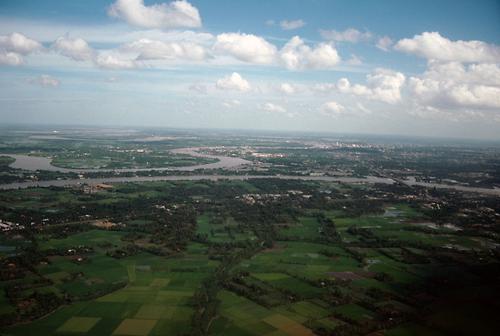
At the airport we immediately booked the next flight to Phnom Penh for the following day at 8.00am. Fortunately, we were standing in the front of a long queue of people waiting, so we still got seats for Phnom Penh. We also booked the flight from Saigon back to Bangkok from there. Even in front of the airport, there were groups of people who said goodbye to a total of more than a hundred Vietnameses emigrating to Canada. There were many tears and hugs.
We had to stay in Saigon. My old travel guide suggested the Kim Do Hotel in Saigon, in which we booked two rooms. It was the old Royal Hotel Kim Do, once the best hotel in Saigon and Vietnam, where even the dazzling and interesting ethnologist Alexandra David-Neel had descended and danced when she was young. In the meantime, most things in the hotel, which was still marked by the Vietnam War, hardly worked. If we wanted to take a shower, we had to shout down the stairs and the water was switched on from the ground floor. Then, due to the outside temperatures, we were able to take a controlled temperature shower, fill up the water bottles and add Mikropur, a common water disinfectant, to the water. In addition, during the showering phases, a waterfall on the back facade of the hotel, which came from an unrepaired, leaky water pipe, plunged into the depths. After showering, the water was shut off again. Since the door locks of the first two rooms on the third floor did not work, we had to swap rooms to at least lock up the luggage.
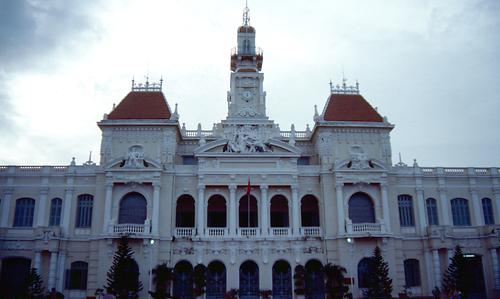
Then we roamed the area surrounding the hotel. Much damage was still showing due to the war 15 years after the victory of the Vietcong over the Americans and the end of the murderous Vietnam war. The reason for the very slow recovery of the country was the American embargo following the war and the years of isolation of the country. When it got dark, only the main square with the hotel was reasonably well lit by a few lamps; but in the rooms of the hotel there was no electricity; the glow of the light from the square helped to orientate oneself in the rooms and in the hotel.
In the smaller byroads of the city we could not have walked without flashlights, because of the dark. Some back roads had no lighting. Sewer covers were missing on the sidewalks sometimes, and even on one of the streets a deep black hole yawned at one point, exposing the view sewage. Small fires along the roadside, where people cooked, threw a spooky red light on the nearby facades and under the trees. Deep potholes made some roads to an adventure track for the many mopeds.
We bought bread, tomatoes, canned tuna, biscuits, chocolate and drinks in a small shop, including a bottle of the notorious Mekong whiskey. So we had something to eat for the next morning and a disinfection for the Cambodia trip. In a small restaurant we ordered a hot soup with rice, chicken and some vegetables.
The plane took off two and a half hours later than planned next morning. After only 25 minutes, we already landed at the airport of Phnom Penh in Cambodia. The weather was rainy. In the long descent we could make out many small circular water surfaces in the fields under the cloud cover through the windows. The mirroring circular surfaces formed strings again and again. They were probably unenclosed bomb craters from the Cambodia war between Vietnamese and the Khmer Rouge, filled with water.
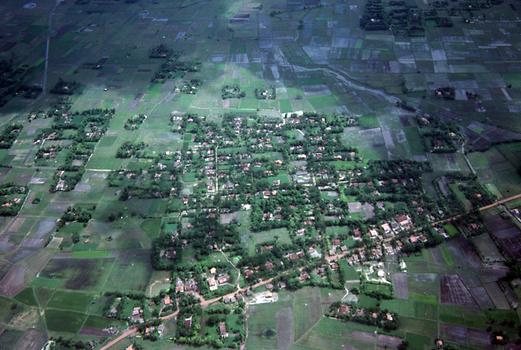
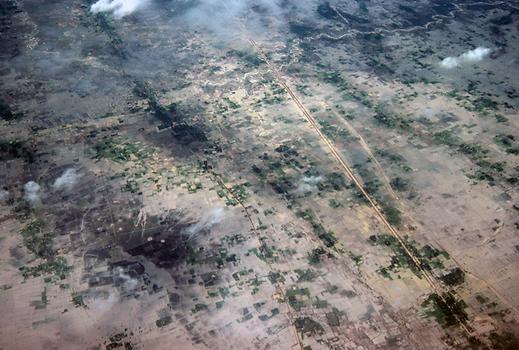
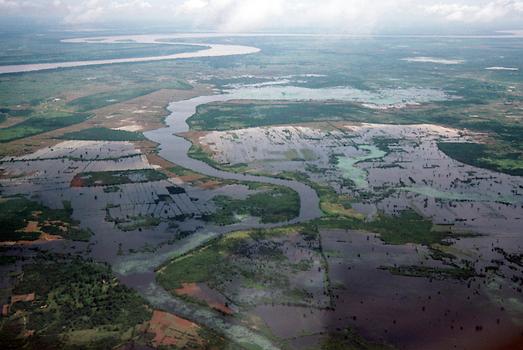
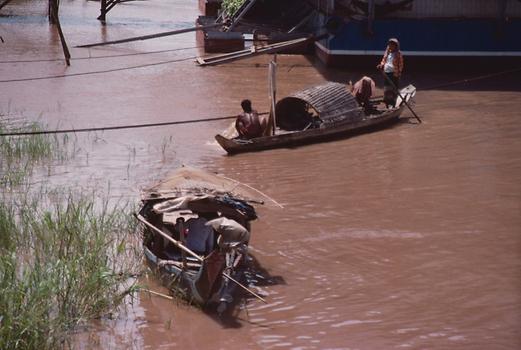
At the airport we also tried to book the return flight immediately. But this time we were not lucky. The flights of the next two weeks were already booked. Therefore, we had to look for an alternative to return in time for our already booked flight from Saigon to Bankok. At that time you could not travel directly to Thailand. When we came out of the airport building later than the other passengers, there were only rickshaws. The former city buses have been used for workers transport. The rickshaw rented by us took about three quarters of an hour to travel to the not very distant center of the capital. The old mansions as well as the modern reinforced concrete skeleton buildings in the center were now surrounded and overgrown by bamboo huts in gardens, on balconies and on the flat roofs. The rural population brought into the city by Pol Pot favored the more airy bamboo-built, palm-leafed huts they knew from the countryside, and avoided the stuffy masonry buildings. The surviving part of the urban population, who had been sent to the countryside, had only partially returned to the cities. In 1990 Phnom Penh was a city with about 600,000 inhabitants, but without infrastructure.
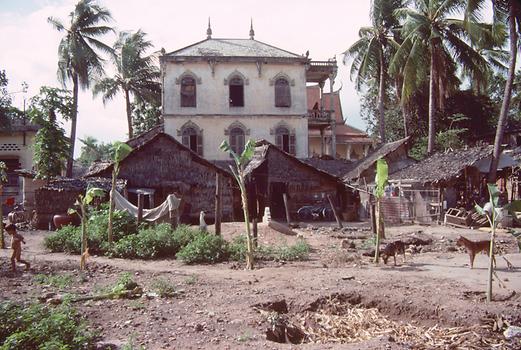
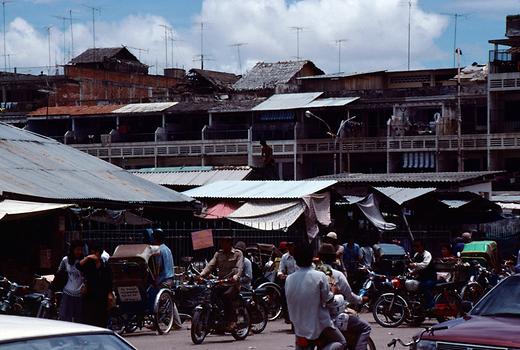
The water network was damaged in so many places that the water could be switched on again only for a very short time each day. Then it poured out of faucets into canisters, but at she same time it plunged down the balconies and the façades of several buildings, and began to spout in streets from breaks of underground piping in the form of mighty fountains.
Right next to the river which drains the Tonlé Sap Lake into the Mekong, we were lucky enough to find one of the rare quarters with air conditioning at an acceptable price. When I looked at the map, I was very confused about the flow direction of this connecting river. Only later I learned that the river changes its direction of flow twice a year. Normally, during the dry season, it transports the excess water from the Tonlé Sap Lake that enters through the tributaries to the Mekong River. In the Mekong river, however, more than four times as much water as normal flows during the rainy season, and then it has a higher water level than the lake. The water level of the Mekong is then up to 12 m higher than that of the Tonlé Sap lake. A large part of the Mekong water then flows into the Tonlé Sap lake. This lake is then the largest natural retention basin on our globe. The Tonlé Sap River therefore changes its direction of flow twice a year - in the rainy season it flows almost upstream.
The water level of the lake also rises up to about 10 m and its surface increases more than fourfold. Some of the houses at the lake are therefore built on flattened terps, on a kind of pyramid of soil. At high tide these pyramids disappear into the water and the houses stand on their upper small platforms like on tiny islands. Most of the houses along the lake shore and along the Mekong, on the other hand, are built on high supports or on floats with lateral vertical guide bars, where these stationary "houseboats" are guided vertically during the rainy season without changing their position. At high tide they form whole floating villages. All these houses are then only accessible by boat from the mainland. Not far from the hotel in Phnom Penh was a small company with many bicycles in front of it. We asked some workers how long they were working and if we could borrow three of their bikes. For one dollar each we were mobile. It had stopped raining, even blue spots and sometimes also the sun appeared in the sky. In the next few days the weather should get relatively good, despite the rainy season.
When we paid our quarters in dollars, we got the change back in Cambodian Riel. Although it was a relatively small repayment amount, we received a tied paper money package of about one liter in volume and a few loose bills. For an Austrian purse these banknote quantities were not suitable. The money we put in a plastic bag and then in one of the small baskets on the handlebars of the three bicycles and drove to the center and the central market.
In contrast to Saigon, where the streets were frequented by tens of thousands of mopeds, there were almost exclusively bicycles in Phnom Penh on the wide roads. Later in the afternoon, at about 4:30 pm, at peak time, we found ourselves in a sea of a hundred thousand bicycles on the main thoroughfare of the city. We quickly learned that it takes some driving technique to work through one side of a double-lane roadway before turning off. The flexible and somethimes even friendly reaction of drivers makes the chaos bearable. Yet accidents do happen, and can easily involve 20 bikes. This can lead to serious trffic jams of bikes! But we drove to the central market first and bought, among other things, fruits and bread. The French fragrant bread, the characteristic "baguette", is one of the few remaining French cultural assets from the colonial era. One still knows how to make it very tastily. When we paid, the "money briquet" was unleashed and counted by an unpredictable fast money counter. A small part was returned to us. The National Bank received 380 Riel for one dollar and 450 Riel for a money changer. So for $ 20 we got 9,000 Riel in 180 50s - again a money briquet.
Then we drove to the train station to get a ticket to Saigon. However, the station was barricaded with heavy chains and rusted padlocks, the train service had apparently been discontinued for a long time and shrubs and trees were already growing on the tracks. They showed that this condition had been lasting for a very long time.
The question of buses or ferries on the Mekong was answered negatively. The only multi-person overland companions were mopeds with trailers. These were breakneck vehicles: The trailer often consisted of only an elongated rectangular wooden platform with a low rim mounted on a central axle with two wheels. This axle was connected to the moped via a long stiff rod or had a short connection between moped and loading area. The platform often carreid around 20 adults with children and a lot of luggage. On the bad roads, the platforms and their scooter began to oscillate even at low speeds resulting in major technical driving difficulties.

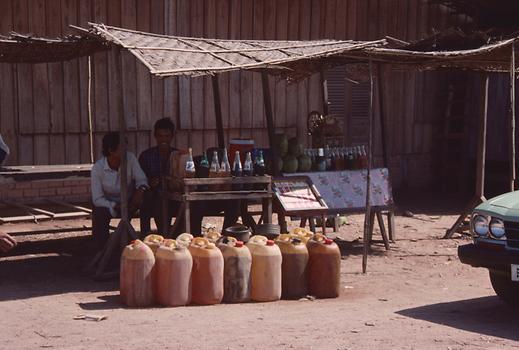
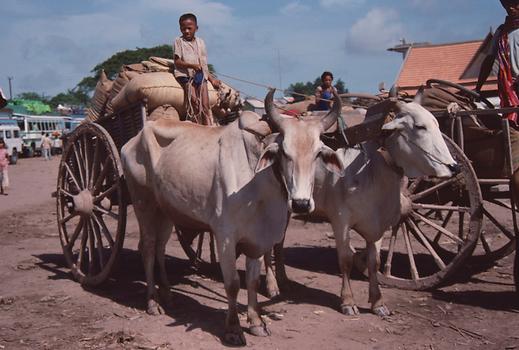
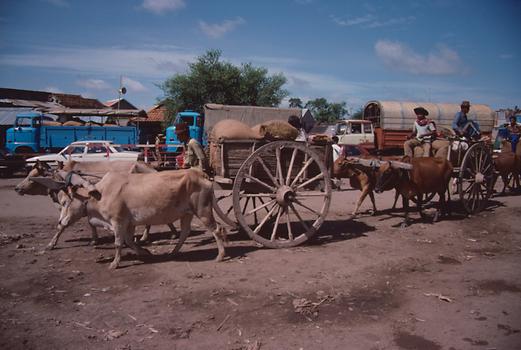
As we saw later, there were stalls on the highways irregularly spaced with numerous 1, 1.5 or 2 liter bottles from Coca-Cola, Fanta and other companies. They obviously did not contain the original juice. It was clear that it could not be self-made soft drinks. When we saw that the liquid was filled into the tank of one of the mopeds it was clear that we were seeing small private gas stations selling a two-stroke mixture.
Since we somehow had to organize our return trip to Saigon, I came up with the idea that perhaps the total of about ten cars that we had seen in the country might have been part of the ministries and we might have a chance to rent one of these cars, if we talked to the foreign minister. So we drove to the Ministry of Foreign Affairs and asked in the office. As luck would have it, the minister had to fly abroad the next day and we could rent the car and the driver. We hired him together with the driver of the minister for the day after tomorrow and for several days before our return flight from Saigon to Bangkok. The drive to Saigon should cost $ 100. We thought we had solved the problem of the non-existent return flight between Phnom Penh and Saigon. Later we realized that this was a big mistake.
We also applied for a four-day permit for Angkor there. Angkor was not reachable by land in 1990. At that time the troops of Pol Pot operated again intensely in the forests around Angkor. The Kampuchea airline had planes once a week to Siem Reap. The flight was booked out for a long time. Therefore, we negotiated with a representative of the Ministry of Defense at the Tourism Office. With his help we now wanted to try to get a military flight to Siem Reap to visit Angkor. We were told that the decision would be made only the next day.
In the evening we went to a boat on the Mekong. The boat was also used as a hotel and we got well tasting, typical Cambodian food. There was a soup next to the obligatory rice, which was served and heated in an ring shaped vessel. The soup pot consisted of a horizontally cut torus. In the center of the construction, there was a charcoal stove that kept the soup boiling, so that you could cook pieces of your vegetables and so not only change the taste but also disinfect the food. The vegetables cooked this way in the soup tasted really good.
The next day we already were in the tourist office at 7:15 clock with the bicycles; we were asked for patience. Therefore, we next visited the Royal Palace with its characteristic buildings with the curved roof shapes. Right between the traditional forms of the palace, I noticed a real foreign object, a building with typical elements of an early European façade. A closer look revealed that the roof was partly damaged and plants were already growing inside.
It was a building used by the last king of Cambodia, Prince Norodom Sihanouk, on the ground floor for representation purposes and upstairs as a working area. As we looked at the structure closely, we noticed a Cambodian-born Parisian architect inspecting the building and taking notes.
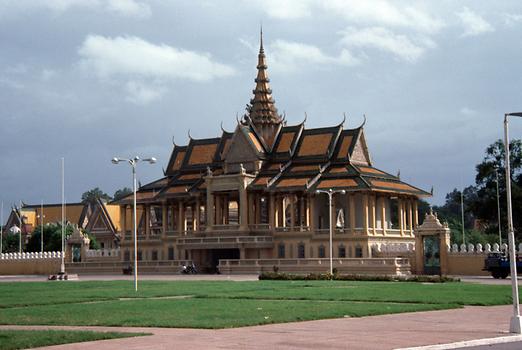

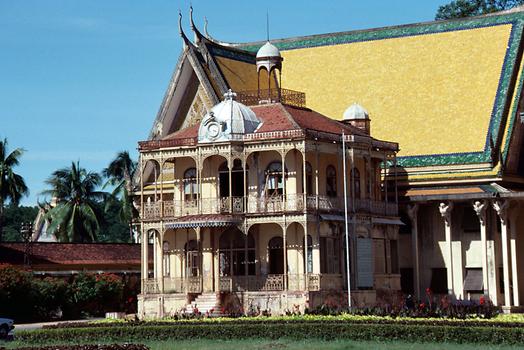
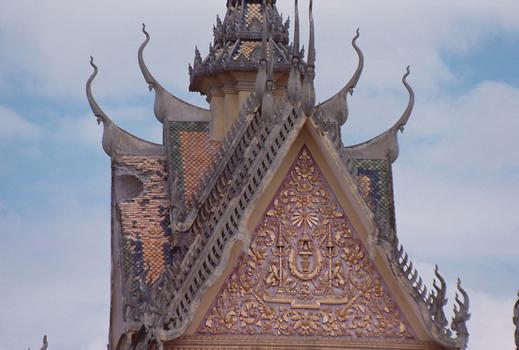
We talked to the architect, with Ingrid Schmiederer translating between French and German. The architect was commissioned by the French government to estimate the expected reconstruction and refurbishment costs for this structure. The idea was to start rehabilitating the building in December 1990, the cost of which would be borne by Paris.
We learned that the structure damaged by Pol Pot was an early precursor of future prefabricated buildings. It consists of individual cast iron prefabricated parts, designed and prefabricated in France in the mid-19th century and assembled on the Suez Canal in 1867 to serve as a temporary home for the inauguration ceremonies of the Napoleonic III Canal, built in between 1859 and 1869, and at the same time to show the most recent French version of technology and progressive architecture Architektur.
After the festivities, the building was dismantled again, brought back on a ship and this time transported to Cambodia and made there the gift of France to the King of Cambodia. From 1864 to 1949, Cambodia was a French protectorate. France was a leader in the field of cast iron prefabrication. Only a little later in 1889, the much more spectacular 324 m high Eiffel Tower followed, which was built of 18,038 prefabricated iron parts for the then world exhibition.
Through a friend of the Cambodian-French architect, we were then led to the silver pagoda - this usually requires the approval of the Ministry of Interior. Nevertheless, the visit was made possible by a representative of the Ministry of Culture who was also there. The silver pagoda is also called Pagoda of the emerald Buddha. Its floor is made of solid silver tiles. The Emerald Buddha was surrounded by numerous gifts of noble families. All this dates from the 19th century. Just in front of the famous Buddha stands a very high-quality Buddha sculpture from the 6th century. Outside, the silver pagoda is surrounded by a high wall. On the inside of this wall the Ramajana myth is shown in the form of a giant fresco. It shows clear similarities with the Wat Prah Keo in Bangkok.
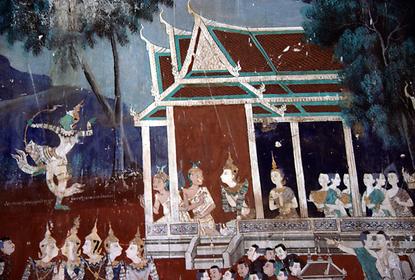
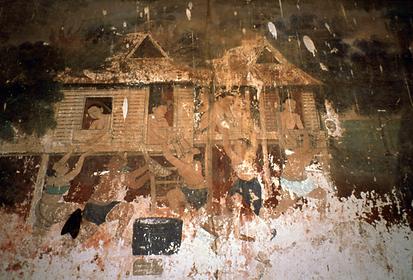
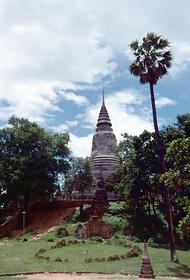
Afterwards we took a boat on the Mekong, taking the rented bicycles along, had lunch there and arrived at Wat Phnom on an artificial hill from the 14th century.
When we got back to the airline later, there was only one seat for the three of us in the plane the next morning. After much negotiation, we were assured that all three of us could fly to Angkor the next day. Everyone had to pay 91 US dollars for the flights including the airport tax. In the evening we went to the ship again for a good dinner.
The next day we got up at 5:45 am with the help of my alarm clock. There was a quick breakfast. Pickup was at 6:30 am; at 7:00 clock we arrived at the airport. At 8:15 we flew to Siem Reap and arrived there at 9:00 clock. We flew in a military transporter. Three soldiers had been put in the luggage room so we could fly. It was a Russian Iljuschin propeller engine of older design. There was such a noise in the plane that one did not understand ones own word. During the flight one could easily see the Tonlé Sap River pouring very muddy, light brown water from the Mekong into the Tonlé Sap Lake with huge dirt whirls. On the shore of the lake I could see houses on high pyramids, just on dry land.
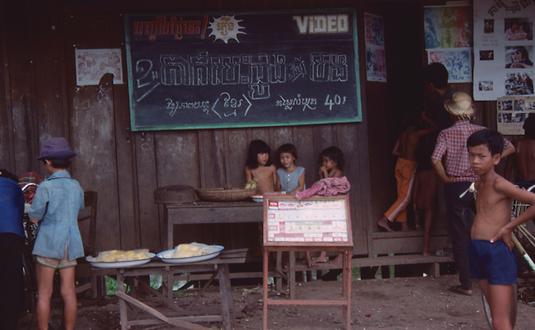


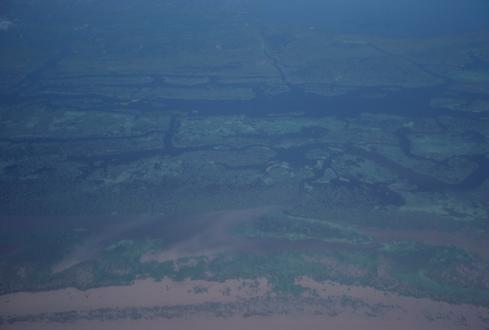
From the airport at Siem Reap we first took a taxi in Angkor to Baksei Chamkrong. This red step pyramid built around 920 AD has a temple of brick, natural stone and stucco on top. Four flights of stairs lead up to it, one on each of the four sides. The temple pyramid resembles Mesoamerican temple pyramids, especially the building I in Tikal in Guatemala, but also the Castillo of Chichen-Itza in Mexico. In the past, this gave occasion to speculation about architectural cultural transfer between the Old and New Worlds. Since the construction was built in the period around 920 AD by Harshavarman I as a temple of memory to his father Yasovarman I, it is younger than the New World temple pyramids.


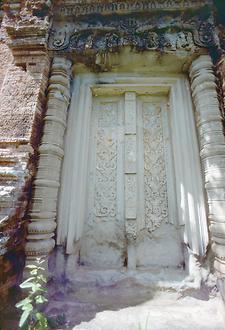
Then we went to Angkor Vat. The world-famous temple complex was built in the early 12th century. Here the dimensions of the Angkor plant are already clear. It takes more than an hour to circumnavigate the Angkor Tom Complex, 5 km in circumference, at walking pace. To go around the high wall of Angkor Thom with its 13.2 km circumference it takes more than three hours. The unbelievable dimensions you can also visualize on the plan of Angkor. From the western end of the western Baray, an artificially created rectangular pond with an edge length of 8.1 km by 2.3 km, to the eastern end of the east, a roughly equal-sized Baray, it is more than 20 km. Angkor Thom was created between the two ponds. South of it is Angkor Vat.
Angkor Vat was desigent for a high visual impact. It is an axially symmetric temple complex that includes several library buildings. I found the dummy-vault-shapings in these library buildings particularly exciting, in which kind of dovetail teeth ensure that no major cracks between the individual stone elements of the vault arise,. Further, in the vertical joints of the roof skin penetrating rainwater is direct ouside by a slope in the teeth of the lateral shocks. These very intricately shaped architectural elements make the mausoleum vaults in many of the Khmer buildings different from all other dummy vaults in the Old and New World. The precision with which these vault stone elements have been molded is amazing.
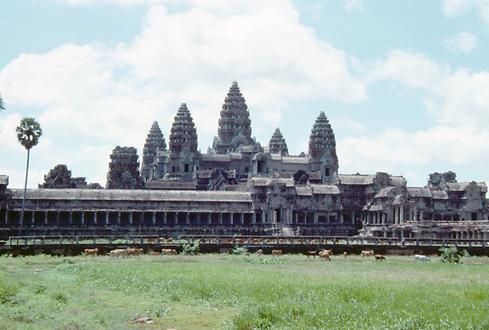
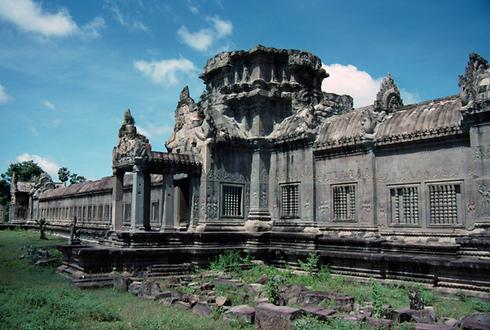

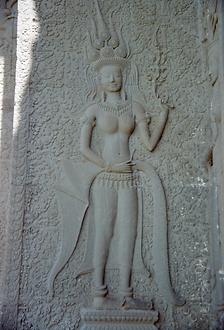
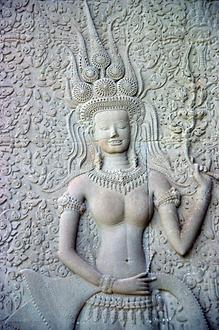
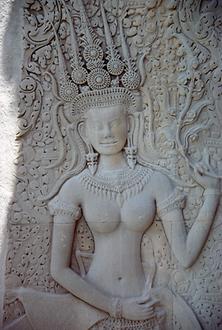
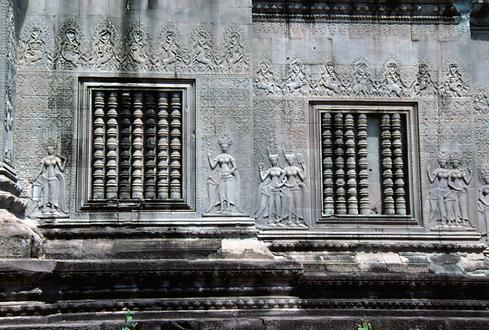

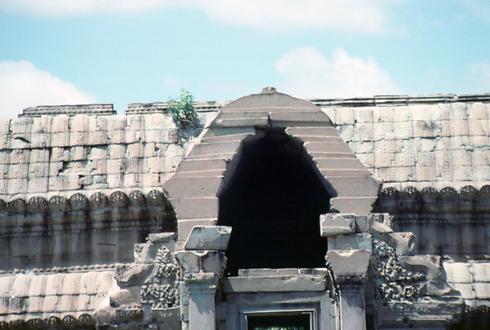
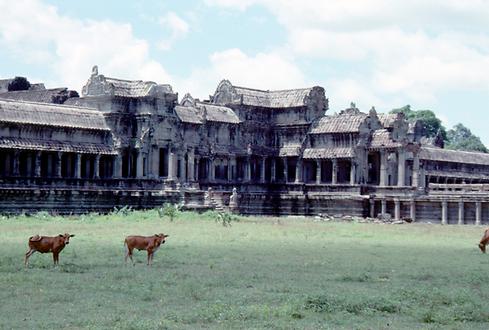
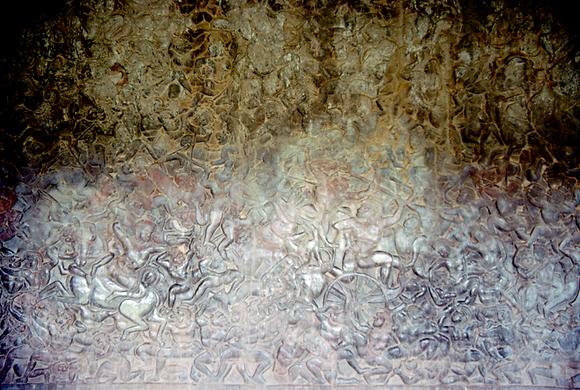
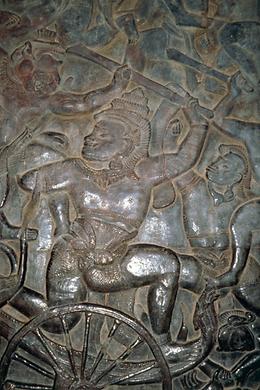
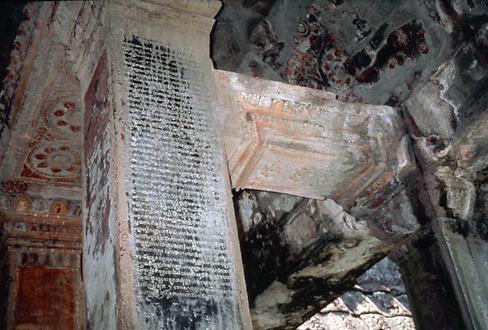

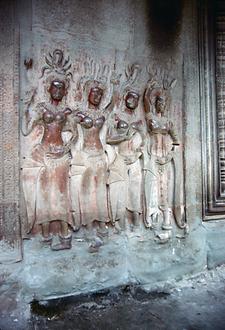
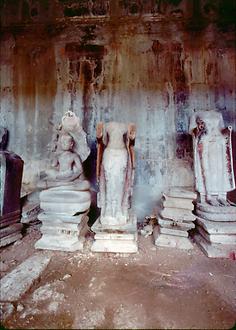
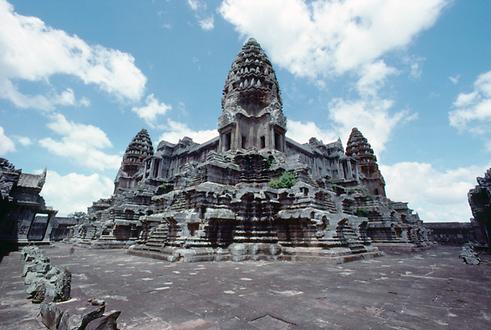
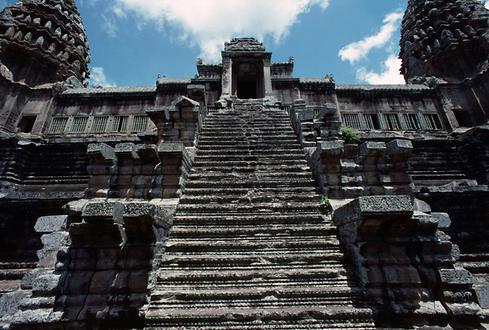
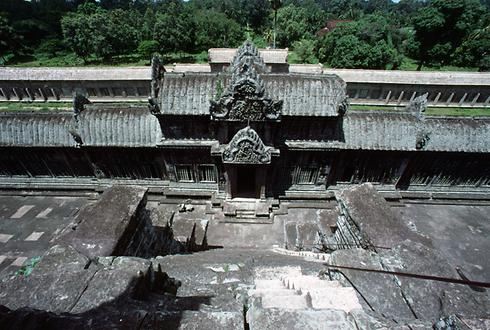
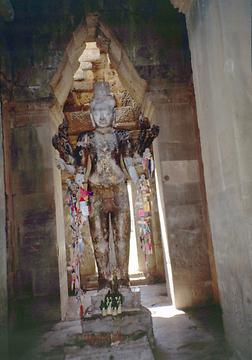
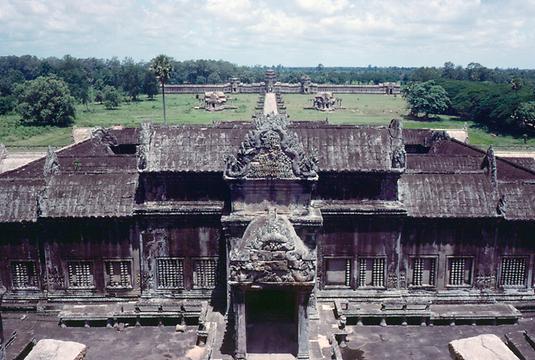
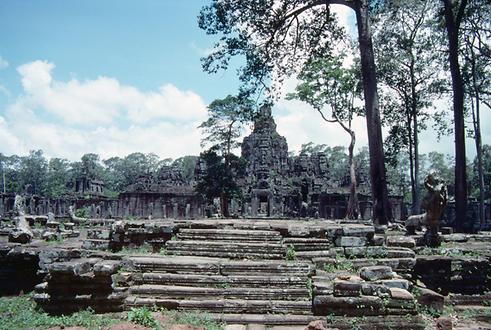

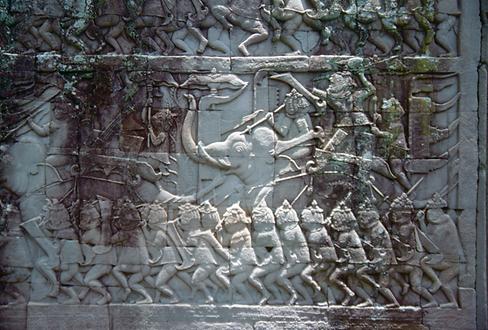

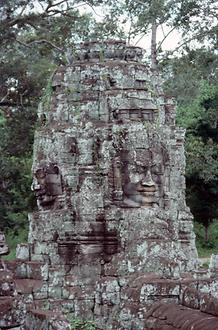
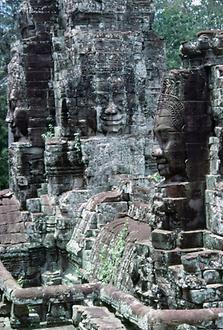
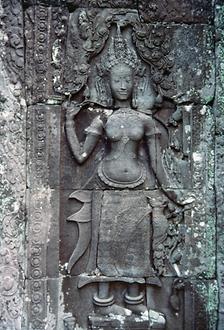

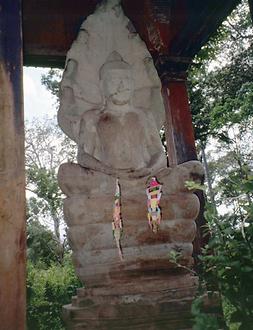
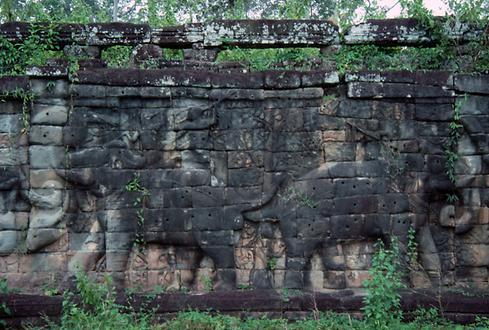

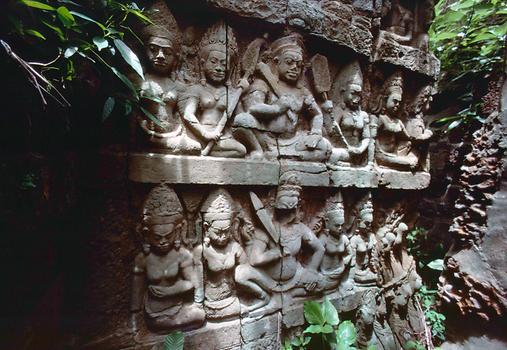
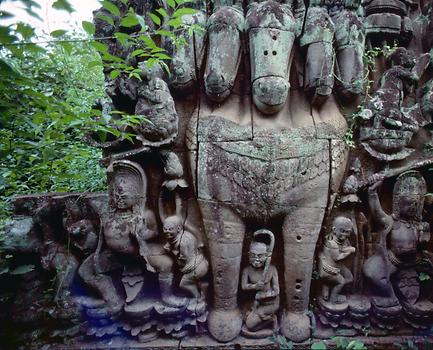
The older reliefs at the elephant terraces in Angkor Thom were completely overgrown and had to be exposed by two people with machetes before we could photograph them. In the distance we could hear occasional shots and later even machine gun fire, an unmistakable sign that in fact in the vicinity of Angkor some fighting was going on. That made us realize that we were in Angkor on a liberated island in the contested Pol Pot area. Pol Pot died only eight years later in 1998 in the woods, probable a natural death.
Already at the beginning of the return flight the air conditioning in the aircraft did not work. The passenger compartment with the many soldiers was soon fogged in so that we could no longer see to the ends of the aisle. A little later the fog became so dense that we could not even recognize our neighbors. The water ran down the windows and there was hardly anything to see outside. In addition, deep rain clouds and emerging evening darkness came again. The announcements in the loudspeaker of Ilyushin were only in Khmer language and thus incomprehensible to us. We flew very low over a long distance. The mood in the aircraft caused considerable concern for the safety of our aircraft.

Before we landed, the situation improved slightly and in the end, the machine safely landed on the runway at Phnom Penh Airport. The sky cleared again on the horizon before sunset, so that a very beautiful rainbow formed on the dark, cloudy opposite side.
The next morning we drove with the car of the foreign minister and his driver to about 40 km away Udong. This small town was the capital between 1618 and 1866 and seat of government of Cambodia. First, we visited a small museum with the remains of the Khmer Rouge massacre. We saw heaps of human bones and skulls.
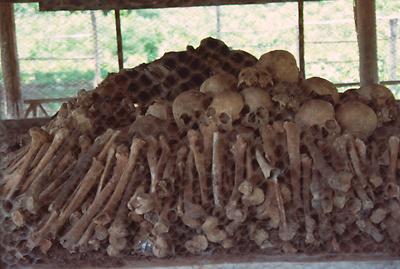
Then, accompanied by two soldiers, two young fellows with incense sticks, and our driver, we climbed up to the stupas on the elongated rock ridge that suddenly rose from the plain. One of the soldiers wore a Chinese, the other a Russian model. Some of the buildings with the tombs of kings at that time were blown up by the Khmer Rouge, as they were considered by them as symbols of the exploitation of the people in a bygone era. But other burial buildings had survived and we wanted to visit them.
Once, as I was about to disappear behind a tree, one of the soldiers quickly held me back, declaring that everything was mined off the road. Every step to the side could be deadly. So I waited until they disappeared behind a bend in the path.
From the ridge of the rock you have a fascinating view over the endless green plain in all directions. The entire environment was created by the Mekong moving gravel an soil. In the direction of Vietnam, the plain expands to the Mekong Delta. Here the plain on the horizon disappeared in the haze. In the vicinity you could see countless plantations with sugar palms.



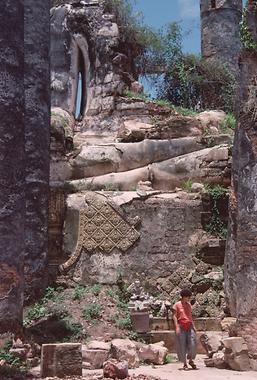
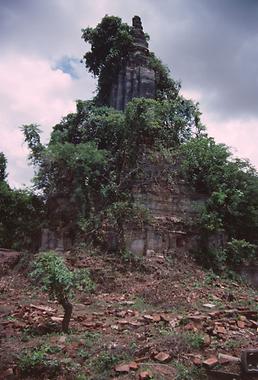
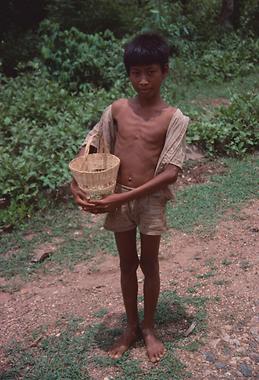
In the afternoon we drove back to Phnom Penh and went to the National Museum. It showed very interesting and beautiful objects that were not optimally placed and labeled. After a good late lunch, we met up with an American woman who wanted to bring at least two Cambodian orphaned siblings to Hawaii for adoption and negotiated with the State Department. A couple from Ohio belonged to a mediation office for adopted children and wanted to take over a whole group of children for mediation.
The next day we went to Ta Keo with the car of the Foreign Minister. This is a temple complex about 90 km south of the capital, built during the reign of Jayavarman V between 968 and 1001 AD. The temple was built of sandstone and never finished. The concept is quite similar to the temples of Jayavarman V in Angkor. A central tower was combined with four lower towers on its periphery. Reliefs that have already been completed show that the temple complex, once completed, may have been one of the architectural highlights of the time of Jayavarman V. Allegedly, the demise of the ruler meant that he was not completed.
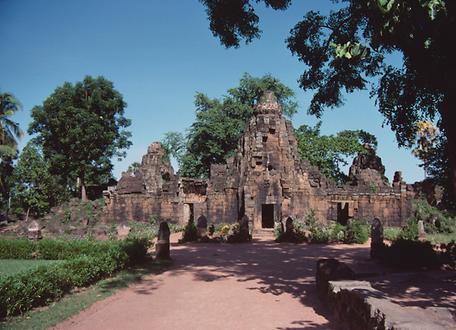
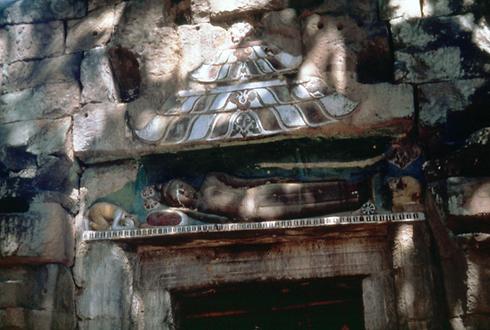

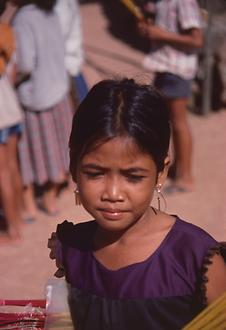
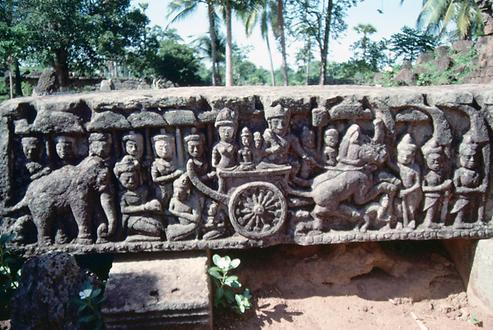


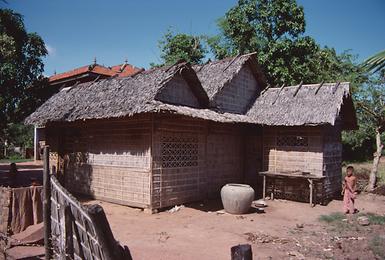
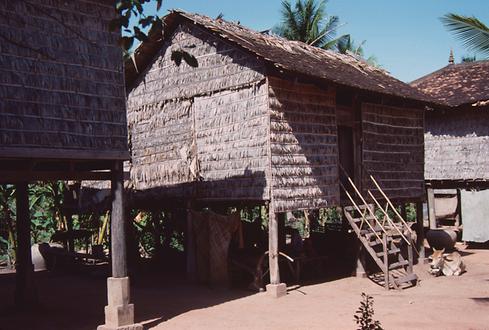

Then we went to the temple complex Ta Prom, which was built by Jayavarman VII in the period from 1181 to 1219. The temple stands on a much older Khmer shrine from the 6th century. In each of the five rooms of the temple there are phallic objects. The complex was relatively well visited by Cambodians in the area. We found out that many locals use colorful, striped cloths to wrap around their heads; In addition, women often wear the Chinese hat, which has the shape of a flat, plaited cone. When I later looked at sculptures and sculpture fragments in an antique shop in Phnom Penh, I realized that they were all imitation and new. Originals were probably already sold in the first phase of the Pol Pot regime to finance the war. Then we had a good dinner as a farewell to Cambodia on the ship. At this point, we did not know yet that this would not be our last evening in the country.
The next morning, at 8:00 am, the minibus headed for Ho Chi Minh City in Vietnam. Along the way, it was noticeable that the roadsides were without garbage like glass bottles, plastic bags or paper. The asphalt merged gently swinging into the dense grass and shrubs of the immediate area. When we got to the Mekong, whose bridge was still destroyed, we had to wait a full hour in a traffic jam with cyclists, trucks, oxen carts and pedestrians on the small ferry. The crossing itsself, however, took only 15 minutes. At about 4 pm we reached the border. Again, we had to wait, but then were let through after checking the passports etc. at the first barrier.

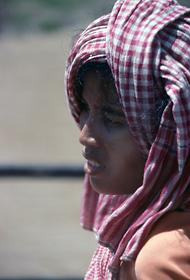

But then came a second check just before the border. The official told us that we had visas that allowed us only to enter and leave by air, rail and ship, but not by the road. He said we would have to go back to Phnom Penh and get another visa from the State Department there. By then it had begun to rain, fitting to our mood. We were almost desperate! It was clear that if we had to go back to the capital we would lose at least two full days and miss our flight to Saigon in Bangkok.
After studying the map, I told the driver to take us to relatively close Svay Rieng - the capital of the province of the same name. There we went to a tourism office, where we actually met someone on Saturday evening. The helpful staff drove us to a small hotel with a French-speaking boss. He said he knew the governor of the province and hoped to motivate him, the next morning, that was a Sunday, to come to the office with some people to help us. He gave us cheap accommodation and phoned to organize the meeting the next day.
When he went to dinner with us, he told us that he survived under the Khmer Rouge only because he threw away his glasses, then fled to the countryside and worked for a farmer looking after pigs. All eyeglass wearers and all academics were at htat poin tin time shot as intellectuals and exploiters. He had been able to survive that way, although he had a good education, was actually a wearer of glasses and was also able to speak French.
At the Governor of Svay Rieng we were greeted friendly in the morning. He then dictated a protocol of our situation which was then read aloud, corrected and rewritten and read again. Then we got our new stamp in the passport. We thanked and drove for the second time to the vicinity of the Vietnamese border arriving at 8:30, despite the very complicated previous procedure. On the way we had problems with the brake of the car and arrived at 9:30 o'clock at the border.
The administration on the border was again quite extensive, but everything worked. The border was clearly visible on the two sides, both by the type of architecture and the traffic on the streets. If there were only bicycles in Cambodia, the many two-wheelers were almost all motorized on the other side of the border in Vietnam. Also, significantly more cars were visible. The roads were wider and better paved in the countryside. In Saigon we arrived at about 12:00 clock, thanked the driver from the Ministr: He had to go back the same day, and said goodbye. We took the Kim Do Hotel again.
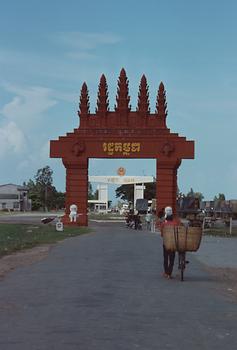
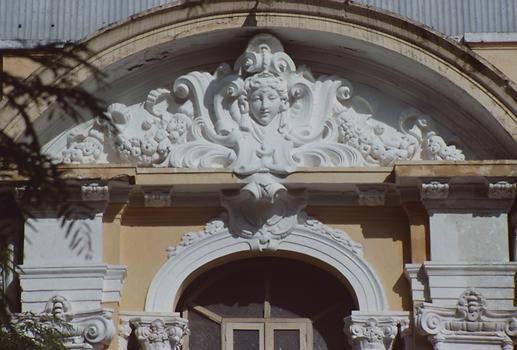
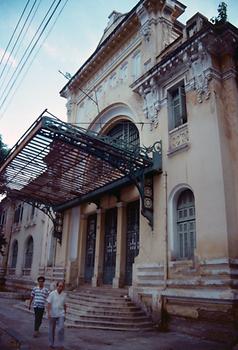
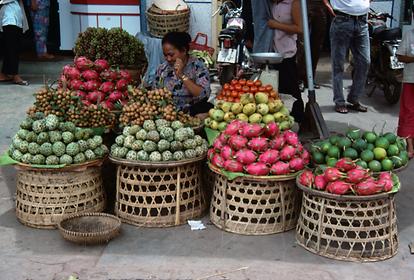
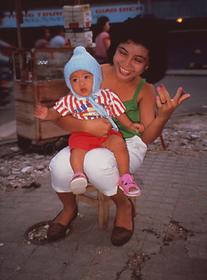
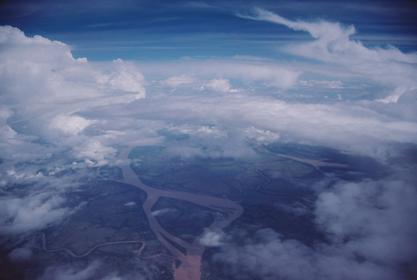
The next day we went on a trip to the Old Pagoda, the Chùa Giác Lȃm Pagoda. We also drove to an old pagoda on the northern outskirts. It was relatively far away from the bus station and a bit hidden, so we had some problems finding it. Anyway, the visit was worthwhile. We also went to the Archaeological Museum: Unfortunately it was closed. Then we went to the French-created zoo of Saigon and in the end we visited the big old market. Then we had our flights confirmed for the next day. The following morning we were headed back to Bangkok and here the western world was back. Thailand was waiting for us.